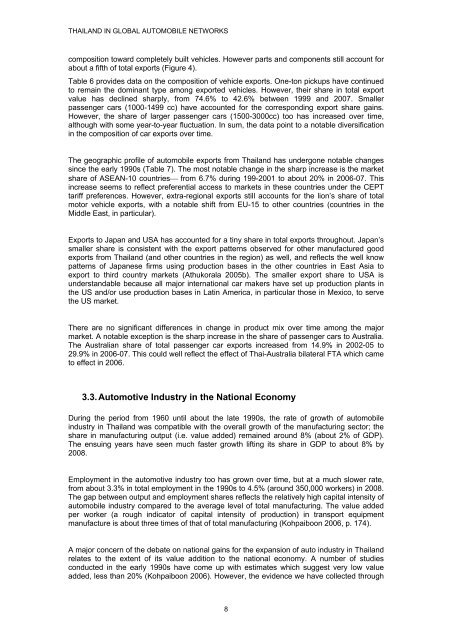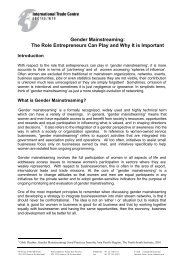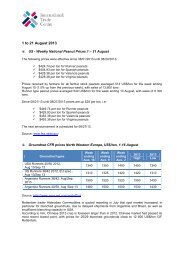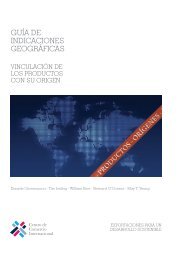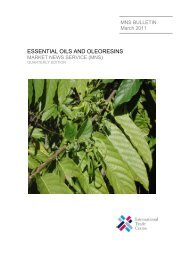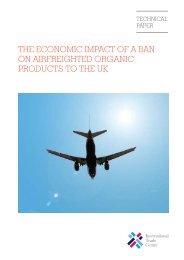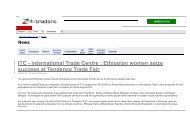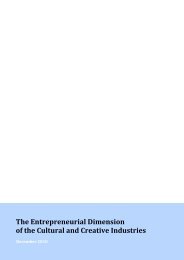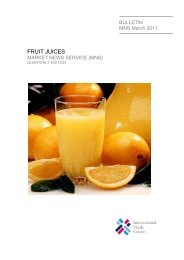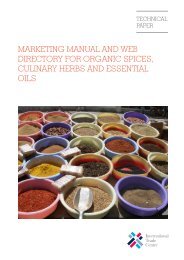thailand in global automobile networks - International Trade Centre
thailand in global automobile networks - International Trade Centre
thailand in global automobile networks - International Trade Centre
Create successful ePaper yourself
Turn your PDF publications into a flip-book with our unique Google optimized e-Paper software.
THAILAND IN GLOBAL AUTOMOBILE NETWORKS<br />
composition toward completely built vehicles. However parts and components still account for<br />
about a fifth of total exports (Figure 4).<br />
Table 6 provides data on the composition of vehicle exports. One-ton pickups have cont<strong>in</strong>ued<br />
to rema<strong>in</strong> the dom<strong>in</strong>ant type among exported vehicles. However, their share <strong>in</strong> total export<br />
value has decl<strong>in</strong>ed sharply, from 74.6% to 42.6% between 1999 and 2007. Smaller<br />
passenger cars (1000-1499 cc) have accounted for the correspond<strong>in</strong>g export share ga<strong>in</strong>s.<br />
However, the share of larger passenger cars (1500-3000cc) too has <strong>in</strong>creased over time,<br />
although with some year-to-year fluctuation. In sum, the data po<strong>in</strong>t to a notable diversification<br />
<strong>in</strong> the composition of car exports over time.<br />
The geographic profile of <strong>automobile</strong> exports from Thailand has undergone notable changes<br />
s<strong>in</strong>ce the early 1990s (Table 7). The most notable change <strong>in</strong> the sharp <strong>in</strong>crease is the market<br />
share of ASEAN-10 countries⎯ from 6.7% dur<strong>in</strong>g 199-2001 to about 20% <strong>in</strong> 2006-07. This<br />
<strong>in</strong>crease seems to reflect preferential access to markets <strong>in</strong> these countries under the CEPT<br />
tariff preferences. However, extra-regional exports still accounts for the lion’s share of total<br />
motor vehicle exports, with a notable shift from EU-15 to other countries (countries <strong>in</strong> the<br />
Middle East, <strong>in</strong> particular).<br />
Exports to Japan and USA has accounted for a t<strong>in</strong>y share <strong>in</strong> total exports throughout. Japan’s<br />
smaller share is consistent with the export patterns observed for other manufactured good<br />
exports from Thailand (and other countries <strong>in</strong> the region) as well, and reflects the well know<br />
patterns of Japanese firms us<strong>in</strong>g production bases <strong>in</strong> the other countries <strong>in</strong> East Asia to<br />
export to third country markets (Athukorala 2005b). The smaller export share to USA is<br />
understandable because all major <strong>in</strong>ternational car makers have set up production plants <strong>in</strong><br />
the US and/or use production bases <strong>in</strong> Lat<strong>in</strong> America, <strong>in</strong> particular those <strong>in</strong> Mexico, to serve<br />
the US market.<br />
There are no significant differences <strong>in</strong> change <strong>in</strong> product mix over time among the major<br />
market. A notable exception is the sharp <strong>in</strong>crease <strong>in</strong> the share of passenger cars to Australia.<br />
The Australian share of total passenger car exports <strong>in</strong>creased from 14.9% <strong>in</strong> 2002-05 to<br />
29.9% <strong>in</strong> 2006-07. This could well reflect the effect of Thai-Australia bilateral FTA which came<br />
to effect <strong>in</strong> 2006.<br />
3.3. Automotive Industry <strong>in</strong> the National Economy<br />
Dur<strong>in</strong>g the period from 1960 until about the late 1990s, the rate of growth of <strong>automobile</strong><br />
<strong>in</strong>dustry <strong>in</strong> Thailand was compatible with the overall growth of the manufactur<strong>in</strong>g sector; the<br />
share <strong>in</strong> manufactur<strong>in</strong>g output (i.e. value added) rema<strong>in</strong>ed around 8% (about 2% of GDP).<br />
The ensu<strong>in</strong>g years have seen much faster growth lift<strong>in</strong>g its share <strong>in</strong> GDP to about 8% by<br />
2008.<br />
Employment <strong>in</strong> the automotive <strong>in</strong>dustry too has grown over time, but at a much slower rate,<br />
from about 3.3% <strong>in</strong> total employment <strong>in</strong> the 1990s to 4.5% (around 350,000 workers) <strong>in</strong> 2008.<br />
The gap between output and employment shares reflects the relatively high capital <strong>in</strong>tensity of<br />
<strong>automobile</strong> <strong>in</strong>dustry compared to the average level of total manufactur<strong>in</strong>g. The value added<br />
per worker (a rough <strong>in</strong>dicator of capital <strong>in</strong>tensity of production) <strong>in</strong> transport equipment<br />
manufacture is about three times of that of total manufactur<strong>in</strong>g (Kohpaiboon 2006, p. 174).<br />
A major concern of the debate on national ga<strong>in</strong>s for the expansion of auto <strong>in</strong>dustry <strong>in</strong> Thailand<br />
relates to the extent of its value addition to the national economy. A number of studies<br />
conducted <strong>in</strong> the early 1990s have come up with estimates which suggest very low value<br />
added, less than 20% (Kohpaiboon 2006). However, the evidence we have collected through<br />
8


